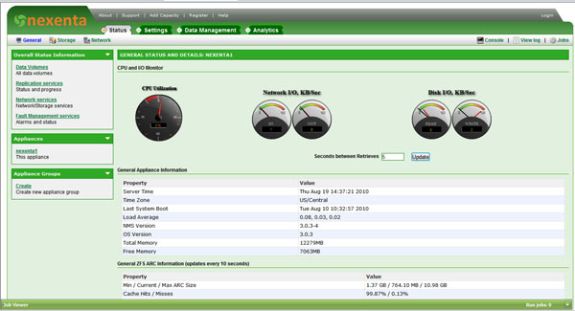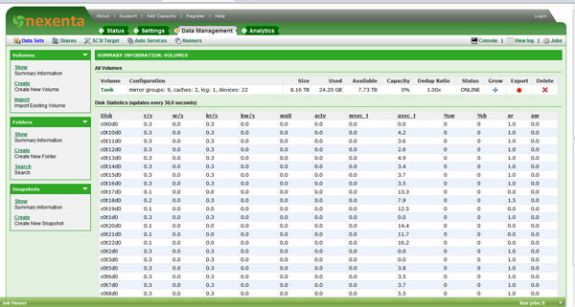ZFS - Building, Testing, and Benchmarking
by Matt Breitbach on October 5, 2010 4:33 PM EST- Posted in
- IT Computing
- Linux
- NAS
- Nexenta
- ZFS
Nexenta
Nexenta is to OpenSolaris what OpenFiler is to Linux or FreeNAS is to FreeBSD. It is a purpose built version of OpenSolaris designed primarily around storage networking including NFS, CIFS, and iSCSI/FC block based storage. Nexenta has taken a lot of time building a great front-end to manage ZFS enabled storage and integrate a plug-in manager that can extend the abilities of a standard x86 platform to rival the best
Nexenta comes in three flavors, Nexenta Core, Nexenta Community, and Nexenta Enterprise. The availability of these three versions allows you to select what kind of product you want, and what kind of expenditures that you will incur.
Nexenta Core is the most basic of the options, but it is also the most forgiving in terms of licensing. Nexenta Core is a command line interface platform only. It is based on an OpenSolaris kernel, and an Ubuntu Userland. There is no limit to the amount of storage that you can configure or use with Nexenta Core, and it is completely free. Nexenta Core can be found here.
Nexenta Community is the next step up. Nexenta Community is based on Nexenta Core, and includes a great GUI interface for managing all aspects of the storage platform. Nexenta Community is also free, but it is limited to 12TB of used storage. Nexenta Community Edition can be found here.
Nexenta Enterprise is the top-level offering. Nexenta Enterprise is a superset of Nexenta Community with many Enterprise level features, including support options. Nexenta Enterprise is licensed based on RAW storage capacity. You can find pricing information here.
Screenshots of web GUI
Nexenta has been very easy to use in our testing. After a few minutes of familiarization with the interface everything is pretty straight forward. You can go from a bare installation to something that has an array configured, an iSCSI target configured, and is ready to take data in a matter of 5-10 minutes. All of the features for sending out notifications and for lighting up indicator lights work as expected and are easy to configure. With just a few menu clicks you're ready to enter all of the information that the system needs to notify you about any problems that it encounters.
Some of the shortcomings that we saw in the Nexenta Enterprise offering were in the reporting and support areas of the product. We did not investigate the reporting problem in depth, as it was not pertinent to the performance data of the system. We would expect that with a little troubleshooting it would be something that would be easily resolved. Throughout the testing process though the daily reports stated that there was no network traffic being generated even though we were loading the interface quite heavily during testing.
This brings us to our next issue that we had with Nexenta, and that was the support channels. We would have gladly troubleshot the issues with reporting if we thought it was going to be done in a timely manner. Since we were using the Enterprise Trial license the support was lackluster at best. We were assured by sales representatives that paid-for support is much faster and much better than the "free trial" support. Free Trial support is treated as their lowest priority support queue. We were not impressed with this as we have always thought of a time-limited free trial period to be pre-sales. If you want to convert someone from a non-paying free trial to a paid product, show them how good the product and support is during that period.












102 Comments
View All Comments
Penti - Wednesday, October 6, 2010 - link
And a viable alternative still isn't available how is Nexenta and the community suppose to get driver support and support for new hardware there, when Oracle has closed the development kernel (SXDE is closed source), meaning that they maybe just maybe can use the retail Solaris 11 kernel if it's released in a functioning form that can be piped in with existing software and distro. They aren't going to develop it themselves and the vendors have no reason giving the code/drivers to anybody but Oracle. Continuing the OpenSolaris kernel means creating a new operating system. It means you won't get the latest ZFS updates and tools any more, at least not till they are in the normal S11 release. Means you can't expect the latest driver updates and so on either. You can continue to use it on todays hardware, but tomorrow it might be useless, you might not find working configurations.It's not clear that Nexenta actually can develop their own operating system, rather then just a distro, it means they have to create their own OS with their own kernel eventually. With their own drivers and so on. And it's not clear how much code Oracle will let slip out. It's just clear that they will keep it under wraps till official releases. It's however clear that there won't be any distro for them to base it on and any and all forks would be totally dependent on what Nexenta (Illuminos) manage to do. It will quickly get outdated without updates flowing all the time, and they came from Sun.
andersenep - Wednesday, October 6, 2010 - link
OpenIndiana/Illumos runs the same latest and greatest pool/zfs versions as the most recent Solaris 10 update.Work continues on porting newer pool/ZFS versions to FreeBSD which has plenty of driver support (better than OpenSolaris ever did).
A stated goal of the Illumos project is to maintain 100% binary compatibility with Solaris. If Oracle decides the break that compatibility, intentionally or not, it will truly become a fork. Development will still continue.
Even if no further development is made on ZFS, it's still an absolutely phenomenal filesystem. How many years now has Apple been using HFS+? FAT is still around in everything. If all development on ZFS stopped today, it would still remain an absolutely viable filesystem for many years to come. There is nothing else currently out there that even comes close to its feature set.
I don't see how ZFS being under Oracle's control makes it any worse than any other open source filesystem. The source is still out there, and people are free to do what they want with it within the CDDL terms.
This idea that just because the OpenSolaris DISTRO has been discontinued, that everything that went into it is no longer viable is silly. It is like calling Linux dead because Mandriva is dead.
Guspaz - Wednesday, October 6, 2010 - link
Thanks for mentioning OpenIndiana. I've been eagerly awaiting IllumOS to be built into an actual distribution to give me an upgrade path for my home OpenSolaris file server, and I look forward to upgrading to the first stable build of OpenIndiana.I'm currently running a dev build of OpenSolaris since the realtek network driver was broken in the latest stable build of OpenSolaris (for my chipset, at least).
Mattbreitbach - Wednesday, October 6, 2010 - link
I believe all of the current Hypervisors support this. Hyper-V does, as does XenServer. I have not done extensive testing with ESXi, but I would imagine that it supports it also.joeribl - Wednesday, October 6, 2010 - link
"Nexenta is to OpenSolaris what OpenFiler or FreeNAS is to Linux."FreeNAS has always been FreeBSD based, not Linux. It does however provide ZFS support.
Mattbreitbach - Wednesday, October 6, 2010 - link
I should have caught that - thanks for the info. I've edited the article to reflect as such.vermaden - Wednesday, October 6, 2010 - link
... with deduplication and other features, here You can grab an ISO build or a VirtualBox apliance here: http://blog.vx.sk/archives/9-Pomozte-testovat-ZFS-...It would be great to see how FreeBSD performs (8.1 and 9-CURRENT) on that hardware, I can help You configure FreeBSD for these tests if You would like to, for example, by default FreeBSD does not enables AHCI mode for SATA drives which increases random performance a lot.
Anyway, great article about ZFS performance on nice piece of hardware.
Mattbreitbach - Wednesday, October 6, 2010 - link
In Hyper-V it is called a Differencing disk - you have a parent disk that you build, and do not modify. You then create a "differencing disk". That disk uses the parent disk as it's source, and writes any changes out to the differencing disk. This way you can maintain all core OS files in one image, and write any changes out to child disks. This allows the storage system to cache any core OS components once, and any access to those core components comes directly from the cache.I believe that Xen calls it a differencing disk also, but I do not currently have a Xen Hypervisor running anywhere that I can check quickly.
gea - Wednesday, October 6, 2010 - link
new: Version 0.323napp-it ZFS appliance with Web-UI and online-installer for NexentaCore and Openindiana
Napp-it, a project to build a free "ready to run" ZFS- Web und NAS-Appliance with Web-UI and Online-Installer now supports NexentaCore and OpenIndiana (free successor of OpenSolaris) up from Version 0.323. With its online Installer, you will have your ZFS-Server running with all services and tools within minutes.
Features
NAS Fileserver with AFP (incl. Time Maschine and Zero Config), SMB with ACLs, AD-Support and User/ Groups
SAN Server with iSCSI (Comstar) and NFS forr XEN or Vmware esxi
Web-Server, FTP
Database-Server
Backup-Server
newest ZFS-Features (highest security with parity and Copy On Write, Deduplication, Raid-Z3, unlimited Snapshots via Windows previous Version, working ACLs, Online Pooltest with Datarefresh, Hybridpools, expandable Datapools=simply add Controller or Disks,............)
included Tools:
bonnie Pool-Performancetest
iperf Net-Performancetest
midnight commander
ndmpcopy Backup
rsync
smartmontools
socat
unzip
Management:
remote via Web-UI and Browser
Howto with NexentaCore:
1. insert NexentaCore CD and install
2. login as root and enter:
wget -O - www.napp-it.org/nappit | perl
During First-Installation you have to enter a mySQL Passwort angeben and select Apache with space-key
Howto with OpenIndiana (free successor of OpenSolaris):
1. Insert OpenIndiana CD and install
2. login as admin, open a terminal and enter su to get root permissions and enter:
wget -O - www.napp-it.org/nappit | perl
AFP-Server is currently installed only on Nexenta.
thats all, no step 3!
You can now remotely manage this Mac/PC NAS appliance via Browser
Details
www.napp-it.org
running Installation
www.napp-it.org/pop_en.html
Mattbreitbach - Wednesday, October 6, 2010 - link
Very neat - I am installing OpenIndiana on our hardware right now and will test out the Napp-it application.